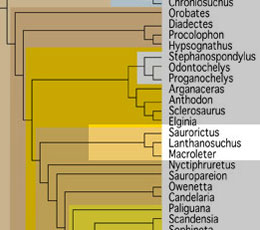With new data come revisions 01/05/12:
I added data on a sister taxon, Saurorictus. See below.
Lanthanosuchus was a flat-headed, aquatic, Late Permian tetrapod known chiefly from a skull. It was originally considered to be a reptilomorph (not a reptile, but in the reptile precursor lineage) by Efremov (1946). Later it was considered a sister to the millerettid, Acleistorhinus (deBraga and Reisz 1996, Cisneros et al. 2004, Lyson et al. 2010). Lee (1997) considered Lanthanosuchus a procolophomorph (along with Owenetta, Procolophon, Proganochelys and others.
Pretty Much All By Itself? Maybe Not.
Like pareiasaurs the skull is rather knobby and sculptured overall. Unlike any potential sister, the skull is fenestrated in the temple region. Since there is no other potential sister with such a flat skull Lanthanosuchus sort of stand alone. Most workers, I presume, view Lanthanosuchus as a sort of dead end taxon. That’s why I was more than surprised to see where it nested in the large study.
[The addition of Saurorictus and Macroleter make it clear that Lanthanosuchus was not derived from the pareiasaurs, but rather formed a clade with Saurorictus and Macroleter. This also clarifies the nesting of Nyctiphruretus, which shares more characters with the equally plesiomorphic Saurorictus.]
Weird Precursor
Lanthanosuchus nests within the Diadectomorpha, outside of the Pareiasauria. Surprisingly it nests at the base of the rest of the Lepidosauromorpha, basal to the precursors to the owenettids and Lepidosauriformes (living lizards, extinct pterosaurs, drepanosaurs, gliding reptiles, owenettids). It’s precursors include pareiasaurs and diadectids. In this regard, Lanthanosuchus was a small, flat diadectomorph (or procolophonomorph).
[The addition of Saurorictus clarifies the evolution of Lanthanosuchus from a Macroleter-like transitional form (Fig. 3)]

Figure 3. Saurorictus, Macroleter and Lanthanosuchus demonstrating the evolution of one to another and another of these sister taxa. Here the lateral temporal fenestra of Lanthanosuchus was a derived character in a dead-end taxon, as many suspected all along.
The Evolution of Lanthanosuchus and the Lanthanosuchia
According to the results recovered by the large tree, a basal pareiasaur, such a Deltavjatia, was a sister to the precursor to Lanthanosuchus and the nyctephruretid, Nyctiphruretus, was a sister to the successor. Together they create a serial size reduction. All these specimens were found in Late Permian (~255 mya) sediments, which means the split and succession occurred earlier and these three taxa represent random branches of a much larger bush of taxa yet to be discovered. Although these three seem quite different from each other, there are no other more parsimonious sister candidates in the present list of taxa.
[The addition of Saurorictus creates a new predecessor taxon outside of the Pareiasauria. The general lumpiness pareiasaurs share with Lanthanosuchus was by convergence.]
What Happened Here?
Lanthanosuchus is the first in this lineage to have a lateral temporal fenestra at the intersection of all the temporal bones. This becomes a lateral temporal embayment with the reduction of the quadratojugal and its separation from the jugal. The parietal shrank to the size of the frontal. The teeth were sharp. The postfrontal fused to the frontal, but that fusion was not found in Nyctiphruretus. Toward Nyctiphruretus, the orbit was increased, the postorbital half of the skull was reduced and skull ornamentation and sculpturing was also reduced, probably by precocial maturity and the retention of juvenile traits into a smaller adult size. In other words, the transition from a bulky, short-tailed herbivore to a small, lizardy insectivore happened during this transition. Successors all remained rather small until the advent of the giant snakes, mosasaurs and pterosaurs.
[As above, the addition of Saurorictus creates a new predecessor taxon outside of the Pareiasauria. General size increase, rather than reduction, gave us Lanthanosuchus with skull fenestrae, reinvented in certain specimens of Nyctiphruretus, but not others.]
As always, I encourage readers to see specimens, make observations and come to your own conclusions. Test. Test. And test again.
Evidence and support in the form of nexus, pdf and jpeg files will be sent to all who request additional data.
References
Cisneros et al 2004. A procolophonid reptile with temporal fenestration from the Middle Triassic of Brazil. Proceedings of the Royal Society London B (2004) 271, 1541–1546 DOI 10.1098/rspb.2004.2748
deBraga M and Reisz RR 1996. The Early Permian reptile Acleistorhinus pteroticus and its phylogenetic position. Journal of Vertebrate Paleontology 16(3): 384–395. doi:10.1080/02724634.1996.10011328.
Efremov JA 1946. On the subclass Batrachosauria – an intermediary group between amphians and reptiles. USSR Academy of Sciences Bulletin, Biology series 1946:615-638.
Lee MSY 1997. Pareiasaur phylogeny and the origin of turtles. Zoological Journal of the Linnean Society 120: 197-280.


